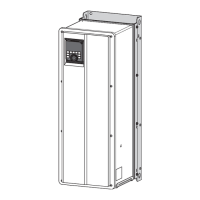34
2. INSTALLATION AND WIRING
2.3 Installation of the inverter and enclosure design
2.3.3 Cooling system types for inverter enclosure
From the enclosure that contains the inverter, the heat of the inverter and other equipment (transformers, lamps, resistors, etc.)
and the incoming heat such as direct sunlight must be dissipated to keep the in-enclosure temperature lower than the
permissible temperatures of the in-enclosure equipment including the inverter.
The cooling systems are classified as follows in terms of the cooling calculation method.
• Cooling by natural heat dissipation from the enclosure surface (totally enclosed type)
• Cooling by heat sink (aluminum fin, etc.)
• Cooling by ventilation (forced ventilation type, pipe ventilation type)
• Cooling by heat exchanger or cooler (heat pipe, cooler, etc.)
Cooling system Enclosure structure Comment
Natural Natural ventilation
enclosed type / open type
This system is low in cost and generally used, but the enclosure
size increases as the inverter capacity increases. This system
is for relatively small capacities.
Natural ventilation (totally
enclosed type)
Being a totally enclosed type, this system is the most
appropriate for hostile environment having dust, dirt, oil mist,
etc. The enclosure size increases depending on the inverter
capacity.
Forced air Heat sink cooling This system has restrictions on the heat sink mounting position
and area. This system is for relatively small capacities.
Forced ventilation This system is for general indoor installation. This is
appropriate for enclosure downsizing and cost reduction, and
often used.
Heat pipe This is a totally enclosed for enclosure downsizing.
INV
Heat sink
INV
Heat
pipe

